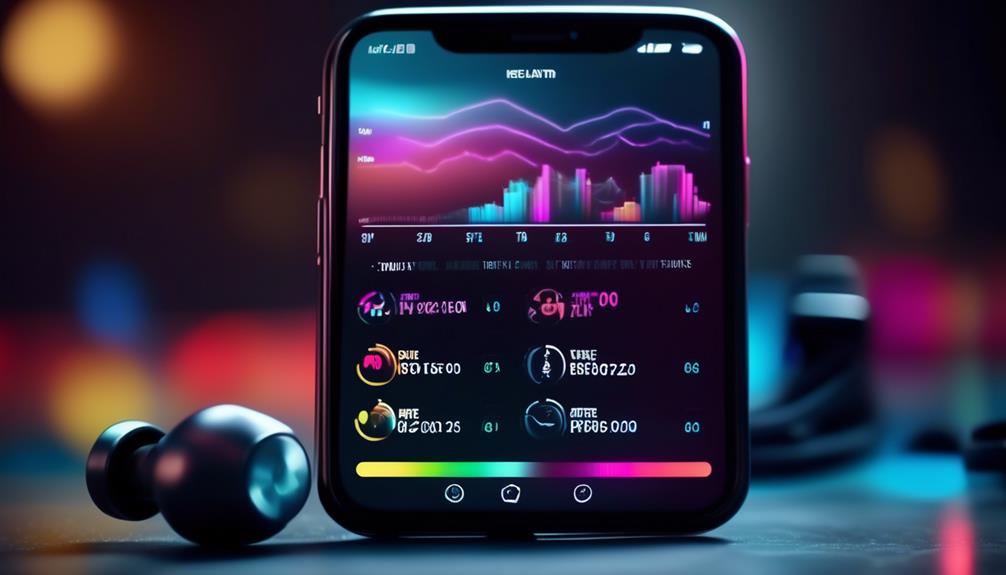Are you tired of struggling to reach your weight loss and fitness goals? Are you ready to finally make a lasting change and achieve the results you’ve always wanted? Well, you’re in the right place.
In this discussion, we will explore the key strategies and steps you can take to transform your health and wellness. From setting realistic goals to incorporating strength training into your routine, we will cover it all.
So, buckle up and get ready to embark on a journey towards a healthier, fitter you.
Setting Realistic Goals

To achieve successful weight loss and fitness outcomes, it’s crucial to set realistic goals that align with your individual capabilities and circumstances.
Creating a support system is one key aspect of setting realistic goals. Surrounding yourself with people who encourage and motivate you can make a significant difference in your weight loss journey. Whether it’s a workout buddy, a supportive friend, or a professional coach, having someone to hold you accountable and provide guidance can greatly increase your chances of success.
Additionally, participating in group fitness classes or joining online communities can also provide a sense of belonging and support.
However, it’s important to remember that obstacles may arise along the way. Whether it’s a busy work schedule, family commitments, or unexpected setbacks, it’s crucial to develop strategies for overcoming these obstacles.
Planning ahead, being flexible, and finding alternative solutions can help you stay on track and continue working towards your goals. Additionally, seeking professional help or consulting with a healthcare provider can provide valuable insights and guidance in navigating these challenges.
Creating a Sustainable Exercise Routine
Creating a sustainable exercise routine is essential for long-term weight loss and fitness success. To help you design effective workouts and stay motivated, here are five practical tips:
- Set realistic goals: Start by setting achievable exercise goals that align with your fitness level and schedule. Gradually increase the intensity and duration of your workouts as you progress.
- Mix it up: Avoid monotony by incorporating a variety of exercises into your routine. This not only keeps things interesting but also targets different muscle groups and prevents overuse injuries.
- Find what you enjoy: Experiment with different activities to find what you genuinely enjoy doing. Whether it’s cycling, dancing, or playing a sport, finding a form of exercise that you look forward to will make it easier to stay motivated.
- Schedule your workouts: Treat your exercise sessions as important appointments. By scheduling them in advance, you’re more likely to stick to your routine and make exercise a priority.
- Get support: Surround yourself with a supportive network of friends, family, or workout buddies. Having someone to hold you accountable and provide encouragement can make a significant difference in staying motivated.
Designing a Balanced Meal Plan
When it comes to designing a balanced meal plan, it’s important to focus on nutrient-rich meal options and portion control strategies.
By choosing foods that are high in essential vitamins and minerals, you can fuel your body with the nutrients it needs to support your weight loss and fitness goals.
Additionally, practicing portion control can help you maintain a calorie deficit, which is necessary for losing weight.
Nutrient-Rich Meal Options
A well-designed balanced meal plan incorporates nutrient-rich options to support weight loss and fitness goals. By focusing on nutrient density, you can ensure that your meals are packed with essential vitamins, minerals, and antioxidants while keeping calorie intake in check.
Here are some nutrient-rich meal options to consider:
- Grilled chicken breast with steamed broccoli and quinoa: This meal provides lean protein, fiber, and complex carbohydrates to fuel your workouts and promote satiety.
- Salmon salad with mixed greens, avocado, and walnuts: This delicious salad is rich in heart-healthy omega-3 fatty acids, vitamins, and minerals.
- Veggie stir-fry with tofu and brown rice: Loaded with colorful vegetables, plant-based protein, and whole grains, this meal is both nutritious and satisfying.
- Greek yogurt with berries and almonds: A protein-packed snack that also provides antioxidants and healthy fats.
- Omelet with spinach, mushrooms, and feta cheese: This breakfast option offers protein, fiber, and essential nutrients.
Portion Control Strategies
To continue your journey towards achieving your weight loss and fitness goals, it’s important to implement effective portion control strategies when designing a balanced meal plan. Portion control is a key component of weight management, as it helps you consume the right amount of food without overeating.
Here are some portion control tips and mindful eating techniques to help you stay on track.
First, be mindful of your plate size. Using smaller plates and bowls can trick your brain into thinking you’re eating more than you actually are.
Next, listen to your body’s hunger and fullness cues. Eat slowly and pay attention to your body’s signals to avoid overeating.
Additionally, try to include a variety of colorful fruits and vegetables in your meals. These low-calorie, high-fiber foods can help you feel full and satisfied.
Understanding the Importance of Portion Control
Understanding the importance of portion control is crucial for achieving weight loss and fitness goals. Portion control refers to managing the amount of food you consume in one sitting, and it plays a significant role in maintaining a healthy weight and overall well-being.
Here are some benefits of practicing portion control:
- Weight management: By controlling portion sizes, you can regulate your calorie intake and prevent overeating, leading to weight loss or maintenance.
- Balanced nutrition: Portion control allows you to include a variety of foods in your diet, ensuring you get the right balance of nutrients.
- Blood sugar control: Controlling your food portions helps maintain stable blood sugar levels, especially for those with diabetes.
- Improved digestion: Eating smaller portions can aid digestion, reducing the risk of discomfort and gastrointestinal issues.
- Mindful eating: Portion control encourages mindful eating, promoting a healthier relationship with food and preventing emotional or binge eating.
To implement effective portion control strategies, consider the following tips:
- Use smaller plates and bowls to visually trick your brain into thinking you’re consuming a larger portion.
- Measure and weigh your food to accurately track portion sizes.
- Listen to your body’s hunger and fullness cues, eating until you’re satisfied, not stuffed.
- Practice mindful eating by eating slowly, savoring each bite, and paying attention to your body’s signals.
- Plan and prepare meals in advance to avoid impulse eating and ensure proper portion sizes.
Incorporating Strength Training Into Your Fitness Routine

When it comes to achieving your weight loss and fitness goals, incorporating strength training into your routine can offer numerous benefits. Not only does strength training help build lean muscle mass, but it also increases your metabolism, allowing you to burn more calories throughout the day.
Effective exercises for strength include weightlifting, resistance band training, and bodyweight exercises. By incorporating these exercises into your fitness routine, you can improve your overall strength and endurance, leading to better results in your weight loss journey.
Benefits of Strength Training
Incorporating strength training into your fitness routine can provide numerous benefits for weight loss and overall fitness. Here are some key benefits of strength training:
- Increased muscle mass: Strength training helps build lean muscle mass, which can boost your metabolism and help you burn more calories throughout the day.
- Improved body composition: Strength training can help you lose fat while preserving muscle, resulting in a more toned and defined physique.
- Increased strength and functional fitness: Regular strength training can enhance your overall strength and improve your performance in daily activities, such as carrying groceries or climbing stairs.
- Enhanced bone health: Strength training can increase bone density and reduce the risk of osteoporosis, especially important for women as they age.
- Better mental health: Strength training has been shown to improve mood, reduce symptoms of anxiety and depression, and boost overall mental well-being.
Incorporating these muscle-building strategies into your fitness routine can help you achieve your weight loss and fitness goals more effectively.
Effective Exercises for Strength
To effectively incorporate strength training into your fitness routine and achieve your weight loss and fitness goals, it’s important to focus on specific exercises that target different muscle groups and promote muscle growth.
Effective exercises for weight loss include compound movements such as squats, deadlifts, and bench presses. These exercises engage multiple muscle groups simultaneously, increasing calorie burn and promoting overall strength.
Additionally, incorporating resistance training exercises like lunges, push-ups, and pull-ups can help build lean muscle mass, which in turn increases your metabolism and aids in weight loss.
Strength training not only helps with weight loss but also offers numerous benefits such as improved bone density, increased muscle strength, and enhanced overall fitness.
Incorporating Strength Into Routine
One effective way to integrate strength training into your fitness routine is by incorporating compound movements that target multiple muscle groups simultaneously. These exercises not only save time but also provide numerous benefits for your overall strength and fitness.
Here are five of the best compound exercises that you can incorporate into your routine:
- Squats: This exercise targets your quadriceps, hamstrings, glutes, and core, helping to improve lower body strength and stability.
- Deadlifts: Deadlifts work your glutes, hamstrings, lower back, and core, promoting overall strength and improving posture.
- Bench press: This exercise primarily targets your chest, shoulders, and triceps, helping to build upper body strength and muscle mass.
- Lunges: Lunges engage your quadriceps, hamstrings, glutes, and calves, enhancing lower body strength and stability.
- Pull-ups: Pull-ups target your back, shoulders, and biceps, improving upper body strength and muscle definition.
Incorporating these compound movements into your routine won’t only help you achieve your weight loss and fitness goals but also provide a well-rounded strength training routine.
Exploring Different Types of Cardiovascular Exercises

Different types of cardiovascular exercises can be an effective way to improve your fitness levels and achieve your weight loss goals. When it comes to incorporating cardio into your routine, there are various options available, each offering unique benefits.
One way to diversify your cardio workouts is by using different equipment. Whether it’s running on a treadmill, cycling on a stationary bike, or using an elliptical machine, equipment allows you to vary the intensity and target different muscle groups.
Additionally, incorporating High-Intensity Interval Training (HIIT) workouts into your cardio routine can be highly effective. HIIT involves alternating short bursts of intense exercise with periods of recovery. This type of workout not only burns calories during the session but also continues to do so even after you’ve finished exercising. It also helps improve your cardiovascular fitness and increases your metabolism.
Remember to choose activities that you enjoy and that align with your fitness goals. Whether it’s a brisk walk, a dance class, or swimming, finding activities that you find enjoyable will help you stay motivated and consistent with your cardio routine.
Experiment with different types of exercises and find what works best for you in achieving your weight loss and fitness goals.
Finding Motivation and Overcoming Plateaus
When it comes to staying motivated and overcoming plateaus in your fitness journey, it’s important to find strategies that keep you engaged and excited about reaching your weight loss and fitness goals. Here are some tips to help you overcome motivation hurdles and break through plateaus:
- Set specific and achievable goals: Having clear, measurable targets will give you something to work towards and keep you motivated. Whether it’s losing a certain amount of weight or fitting into a specific clothing size, make sure your goals are realistic and within reach.
- Mix up your routine: Doing the same exercises day in and day out can lead to boredom and plateaus. Try incorporating different types of workouts, such as strength training, cardio, and flexibility exercises, to keep your body challenged and prevent stagnation.
- Find a workout buddy: Having a partner to exercise with can provide accountability and motivation. Find someone with similar fitness goals and workout together regularly. You can push each other to stay on track and make your workouts more enjoyable.
- Celebrate milestones: Recognize and celebrate your achievements along the way. Whether it’s reaching a weight loss milestone or improving your fitness levels, reward yourself with something you enjoy, like a new workout outfit or a spa day. It will give you something to look forward to and keep you motivated.
- Track your progress: Keeping track of your workouts, food intake, and progress can help you stay motivated. Seeing how far you’ve come can be a great reminder of your achievements and keep you motivated to keep going.
Utilizing Technology and Fitness Apps
Utilizing technology and fitness apps can greatly enhance your weight loss and fitness journey by providing you with useful tools, resources, and tracking capabilities. Fitness technology has come a long way in recent years, and there are now a plethora of apps available that can help you stay on track with your goals.
Fitness tracking is one of the key features of these apps. They allow you to monitor your daily activities, such as steps taken, calories burned, and distance covered. This information can be crucial in understanding your progress and identifying areas where you can improve. By tracking your workouts and daily activity levels, you can make informed decisions about your fitness routine and adjust it accordingly.
Moreover, fitness apps often come with built-in workout programs and exercise libraries. These resources can provide you with a wide range of workouts and exercises to choose from, making it easier to vary your routine and keep things interesting. Whether you prefer strength training, cardio, or yoga, there’s an app out there that can cater to your needs.
In addition, some fitness apps offer features like meal tracking and nutrition guidance. These tools can help you monitor your calorie intake, track your macronutrients, and make healthier food choices. By keeping a close eye on your diet, you can ensure that you’re fueling your body properly and supporting your weight loss and fitness goals.
Tracking Progress and Celebrating Milestones
When it comes to tracking progress and celebrating milestones in your weight loss and fitness journey, there are a few key points to keep in mind.
First, it’s important to set achievable goals that are specific, measurable, and realistic. This will allow you to track your progress effectively and make adjustments as needed.
Additionally, monitoring your progress through methods such as tracking your workouts, measuring your body composition, or using fitness apps can provide valuable insights and help keep you motivated.
Lastly, don’t forget to reward yourself for reaching milestones along the way, whether it’s treating yourself to a new workout outfit or indulging in a small, non-food related treat.
Setting Achievable Goals
To effectively track your progress and celebrate milestones in your weight loss and fitness journey, it’s important to set achievable goals. Setting achievable goals not only helps you stay motivated, but also allows you to measure your progress and make necessary adjustments along the way.
Here are some tips to help you set achievable goals:
- Be specific: Clearly define what you want to achieve, whether it’s losing a certain amount of weight or running a 5k race.
- Set realistic targets: Make sure your goals are attainable and consider your current fitness level and lifestyle.
- Break it down: Divide your overall goal into smaller, manageable tasks to keep yourself motivated.
- Track your progress: Use a journal or a fitness app to record your workouts, measurements, and achievements.
- Celebrate milestones: Reward yourself when you reach important milestones to stay motivated and celebrate your progress.
Monitoring Progress Effectively
To effectively track your progress and celebrate milestones in your weight loss and fitness journey, it’s crucial to monitor your progress effectively by tracking your achievements and celebrating important milestones.
Effective tracking involves measuring progress in a systematic and objective manner. One way to do this is by keeping a journal or using a fitness tracking app to record your workouts, food intake, and measurements. This allows you to see patterns, identify areas of improvement, and stay accountable to your goals.
Additionally, measuring progress through regular assessments such as body measurements, weight, and fitness tests can provide concrete evidence of your progress.
Celebrating milestones along the way is essential for motivation and boosting your confidence. Whether it’s losing a certain amount of weight, reaching a fitness milestone, or fitting into a smaller clothing size, take the time to acknowledge and celebrate your achievements.
This will keep you motivated and inspired to continue on your weight loss and fitness journey.
Rewarding Your Achievements
Rewarding your achievements is an essential component of tracking progress and celebrating milestones in your weight loss and fitness journey. It not only provides a sense of accomplishment but also helps in staying motivated throughout the process.
Here are five ways to reward yourself and stay on track:
- Treat yourself to a new workout outfit or equipment. Looking good and having the right gear can boost your confidence and make you more excited to exercise.
- Enjoy a cheat meal or indulge in your favorite treat. Remember, moderation is key, and rewarding yourself occasionally can help you stick to your healthy eating habits in the long run.
- Plan a spa day or a massage to relax and pamper yourself. Taking care of your mental well-being is just as important as physical fitness.
- Set non-food-related rewards like a new book or a movie night out. This way, you have something to look forward to that doesn’t revolve around food.
- Share your achievements with loved ones. Celebrate with friends and family who support your goals, and let them acknowledge your hard work and progress.
Staying Consistent and Building Healthy Habits
Consistency and healthy habits are key to achieving your weight loss and fitness goals. Building consistency means sticking to your plan and making a conscious effort to maintain healthy habits over time. It’s important to remember that forming habits takes time and effort, but once they’re established, they become second nature and easier to maintain.
To build consistency, start by setting realistic and achievable goals. Break them down into smaller, manageable steps, making it easier to stay on track and build momentum. Create a routine that includes regular exercise and a balanced diet. Find activities you enjoy, whether it’s going for a run, practicing yoga, or joining a fitness class. Consistently incorporating these activities into your schedule will help you form healthy habits.
Another important aspect of building consistency is accountability. Find a workout buddy or join a fitness community to keep you motivated and accountable. Track your progress, whether it’s through a fitness app or a journal. Celebrate your achievements along the way to stay motivated and committed to your goals.
Seeking Support and Accountability
Building a support system and seeking accountability are crucial steps in achieving your weight loss and fitness goals. It’s important to surround yourself with people who understand and support your journey. Here are some ways you can seek support and accountability:
- Join a support group: Being part of a support group can provide you with a sense of community and understanding. You can share experiences, exchange tips, and motivate each other towards your goals.
- Find an accountability partner: Having someone who holds you accountable can greatly increase your chances of success. Choose someone reliable and committed to their own health and fitness goals. Check in with each other regularly, share progress, and offer support during challenging times.
- Utilize online communities: The internet offers a wide range of online communities dedicated to weight loss and fitness. Joining these groups can provide you with a wealth of information, support, and motivation from like-minded individuals.
- Consider professional help: If you feel that you need additional support, consider seeking help from a personal trainer, nutritionist, or therapist. They can provide personalized guidance, support, and accountability tailored to your specific needs.
- Track your progress: Use technology to your advantage by using fitness apps or wearable devices to track your progress. These tools can help you stay accountable by monitoring your activity levels, food intake, and progress towards your goals.
Conclusion
Congratulations on taking the steps towards achieving your weight loss and fitness goals! Remember, consistency is key to success.
Did you know that studies have shown that individuals who track their progress are more likely to reach their goals? Imagine the satisfaction of seeing your progress unfold before your eyes, whether it’s through measuring inches lost or seeing improvements in your strength and endurance.
So keep tracking, stay committed, and celebrate each milestone along the way to a healthier, happier you!


